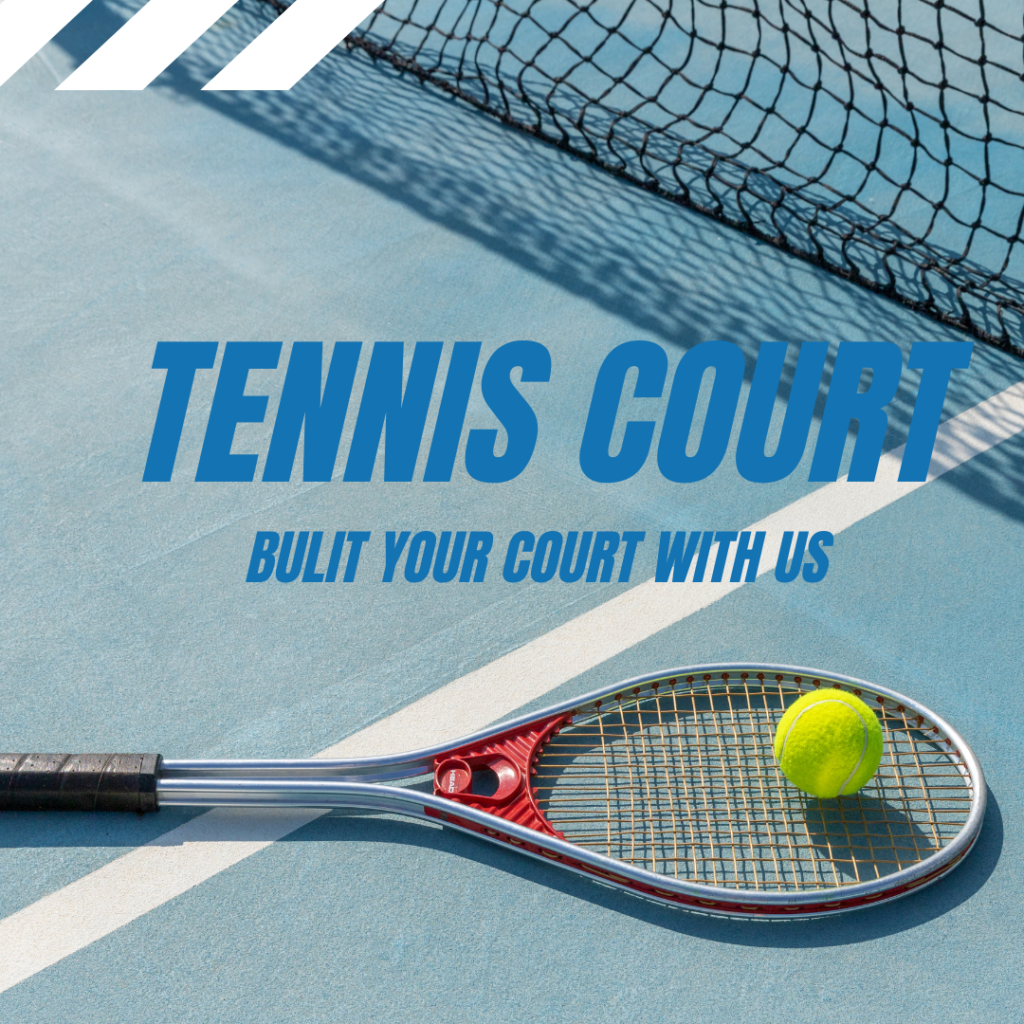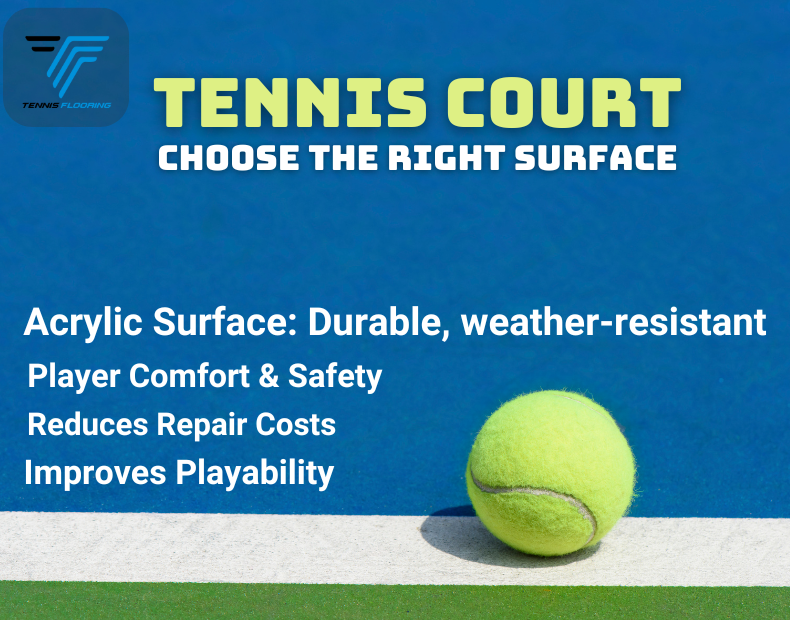It is important that a tennis surface is well constructed to ensure Performance, safety and durability of the court. The choice of tennis court flooring plays a critical role in maintaining consistent ball bounce, player comfort, and surface resilience. Be it for professional competitions or casual play, good choice of materials and installation of tennis court flooring tips and techniques can have great effects on performance, as well as lifespan.
Tennis Flooring will help to know how big a tennis court is, and with the right construction methods, would enable the surface to meet world standard while providing the best playing experience. Ideally constructed courts look aesthetically inviting, require much less maintenance, and provide a safer environment for athletes of all levels.

The Dimensions of a Tennis Court
The ITF lays down the standard size for a tennis court dimensions. And the measurement include:
- Total Length of a Tennis Court: 78 feet.
- Total Width: 36 feet for doubles and 27 feet for singles.
- Service Box Length: 21 feet from the net.
- Net Height: 3 feet at the center and 3.5 feet at the posts.
- Baseline to Net Distance: 39 feet.
- Doubles Alley Width: 4.5 feet on each side.
- Run-Off Area: At least 21 feet behind baseline and 12 feet across the sides for safe playing.
Benefits of Premium Tennis Court Flooring
1. Long Lasting Surface
Premium tennis court flooring can withstand heavy play and various weather conditions. Reduce maintenance costs and get longevity.
2. Safer and More Comfortable Ground
A well installed court minimizes the risk of injuries by giving proper shock absorption and traction. Premium flooring reduces player fatigue and prevents slipping, so you can play safer and more enjoyable.
3. Consistent Ball Bounce and Performance
A professionally built court guarantees uniform ball bounce. High quality surfaces gives right level of grip and response for all level of players.
4. Low Maintenance Courts
Premium tennis court material requires minimal maintenance and retains quality over time. Durable surface means less repair and resurfacing, save time and cost in the long run.
5. Weather Resistant Flooring
Tennis courts are designed to withstand UV rays, rain and temperature fluctuations. Weather resistant flooring prevent cracks and surface damage, so you can play all year round.
Choosing the Right Tennis Court Surface In India
Choosing the right surface depends on playing style, maintenance and climate. Options are acrylic, synthetic and cushioned surfaces, each with its performance and durability benefits.

Maintenance Tips of Tennis Court Surface
The tennis court surfaces can be well maintained and looked after to continue providing top quality, safety and durability. Periodic maintenance ensures that the court lasts longer for play and remains aesthetically beautiful.
Daily Sweep: Dust, debris and organic matter can accumulate on the surface and cause discoloration and lack of traction. Daily sweeping and pressure washing or mild cleaning solutions every now and then keeps the surface in top shape.
Timely Resurfacing: Over time, wear and tear can cause cracks and surface deterioration. Resurfacing every 4-8 years with acrylic coatings keeps the court smooth and playable and prevents further damage.
Drainage Maintenance: Proper drainage prevents water accumulation which can cause surface weakening and moss growth. Regularly inspect and clean drainage channels to ensure water runs off efficiently and the court stays dry and slip resistant.
Crack and Damage Repair: Small cracks can turn into major issues if not addressed. Apply quality sealants and patch minor imperfections early to prevent costly repairs and structural damage.
UV and Weather Protection: Acrylic coatings with UV protection prevents fading and periodic recoating keeps the surface durable against harsh weather.
By following Tennis Flooring tips, tennis court flooring stays in top shape and provides a safe and professional playing experience for years to come.
Installation Tips for a High-Quality Tennis Court
1. Site Preparation
Site leveling, grading and drainage is where it all begins. A solid tennis court base prevents uneven surfaces and extends the life of the court.
2. Base
A stable base is key to long term performance. Concrete or asphalt tennis court bases are used to provide a solid and smooth surface.
3. Acrylic Coating
Acrylic coatings add durability and looks. They also provide slip resistance court for better player safety and performance.
4. Line Marking and Finishing
High quality paint is used to apply precise tennis court line markings to ensure clear and long lasting lines. Alignment is critical for professional play.
How to Fix Tennis Court Flooring Issues?
Through different activities and weather, over time tennis court flooring faces wear and tear. Cracking, fading, and uneven surfaces are the most common problems caused by improper installation and neglecting timely resurfacing and maintenance. Fixing small problems at the beginning avoids bigger repairs and prolongs the life of the court.
Eco Friendly Tennis Court Flooring
Using sustainable tennis court flooring options like recycled materials and water based acrylic coatings reduces environmental impact. Using energy efficient lighting and eco friendly court surfaces makes for a greener sports facility and high performance and durability.
Conclusion
Investing in top quality tennis court flooring means better gameplay, safety and surface durability. Whether professional or recreational, choosing the right materials and installation method means a better playing experience. Knowing the dimensions of a tennis court and following best practices in construction means a court that meets international standards and is long lasting. Get in touch with Tennis Flooring for premium tennis court flooring tips and solutions!
Frequently Asked Questions
According to the ITF, a tennis court size for singles is 78 long and 27 wide in feet. For doubles, it’s 36 ft. A run-off area of 12 ft behind the baseline and 10 ft (3.05m) along the sideline is recommended.
A singles court is faster with precise shots, a doubles court requires teamwork. Run-off areas give you space to move, safety and performance.
Acrylic flooring is best material for tennis court flooring. It provides protection from UV rays, is waterproof and also remains safe from the effects of weather. Acrylic flooring requires less maintenance than other flooring materials.
The surface affects the speed, bounce and velocity of the ball. The ball’s bounce increases, and the impact on joints is reduced. It also provides excellent traction and shock absorption. Choose the right surface for comfort, reduce the risk of injury, and optimize play.
